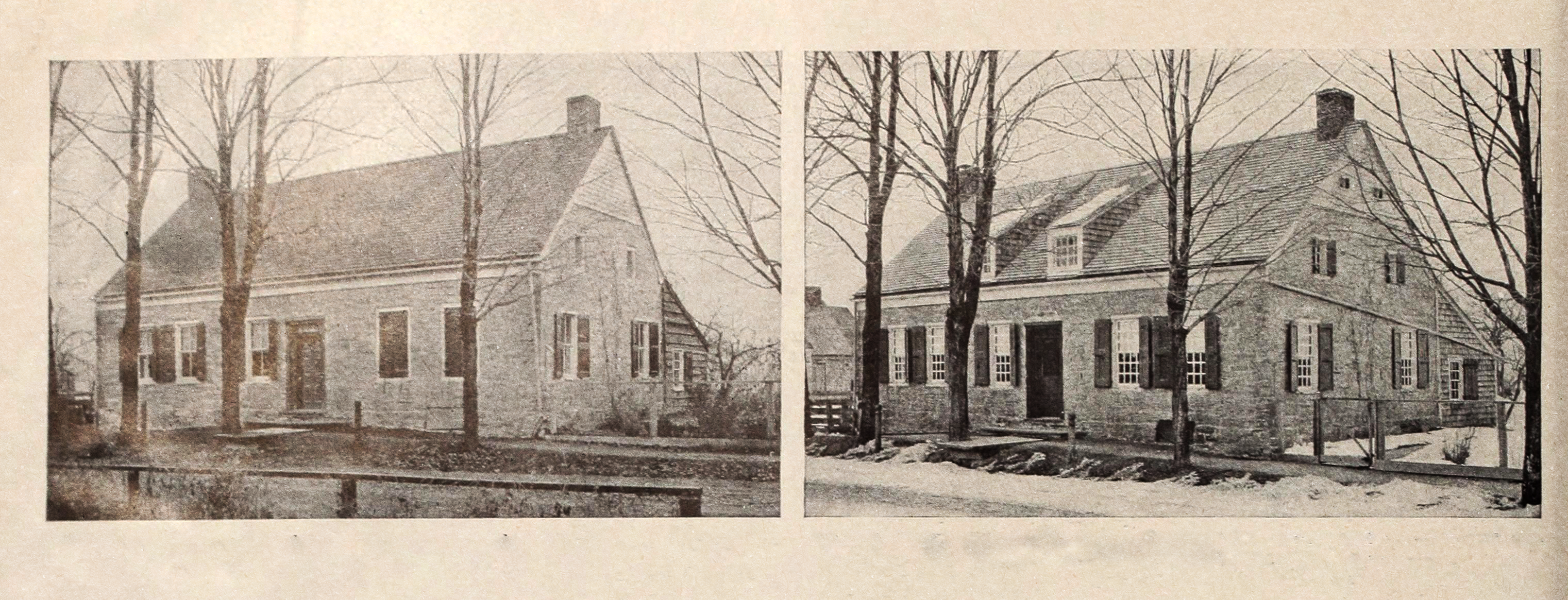Above left photo: The “Senate” House at Hurley, N.Y. as it was when we found and bought it. The grounds comprise about two acres. Above right photo: Our work was principally one of restoration. The small-paned windows and old-fashioned door add much to the appearance of the house.
Having at last found the place* that came near our ideals, we took account of stock and found we had an old story- and-a-half stone cottage with an “L” kitchen. The house has a history, having been the place of meeting, for a short time, of the State “Council of Safety” after the burning of Kingston by the British, in 1777, but it was soon abandoned because the living room could not be kept warm. The type of the house is frequently seen where the Huguenots have settled, as in Staten Island; it is plain and is situated directly on the street, as are all such houses in the village.
Originally it had, on the lower floor, a large hall and three rooms, each having an immense chimney with corresponding fireplace; above, there were two separate garrets, the one over the main floor having a winding staircase from the hall, and that over the kitchen having the steepest possible flight of stairs from that room.
A bedroom had been partitioned off in the living room, and what are now the “den” and a closet were two bedrooms cut off the parlor (now library); the summer bedroom was a later addition, and the kitchen storeroom had been, at some time, cut off from that room; the main garret had two rooms made on the east end and a large room on the west end, leaving in the middle a large open space lighted by a rear skylight.
All the rooms on the main floor have wooden ceilings and heavy wooden beams; the fireplaces had been bricked up, but there were charming upper and lower cupboards in both parlor and living room chimneys.
As the house was originally a farmhouse, we insisted, when making our changes, upon keeping to the original character of the house as much as possible, no matter what conveniences we might wish to install. As the family was fortunate in having among its members a handy man, a sort of “Jack of some trades,” we brought down the expense for labor and had the pleasure of accomplishing much ourselves; we were fortunate also in securing skilled help who appreciated sentiment for the antique.
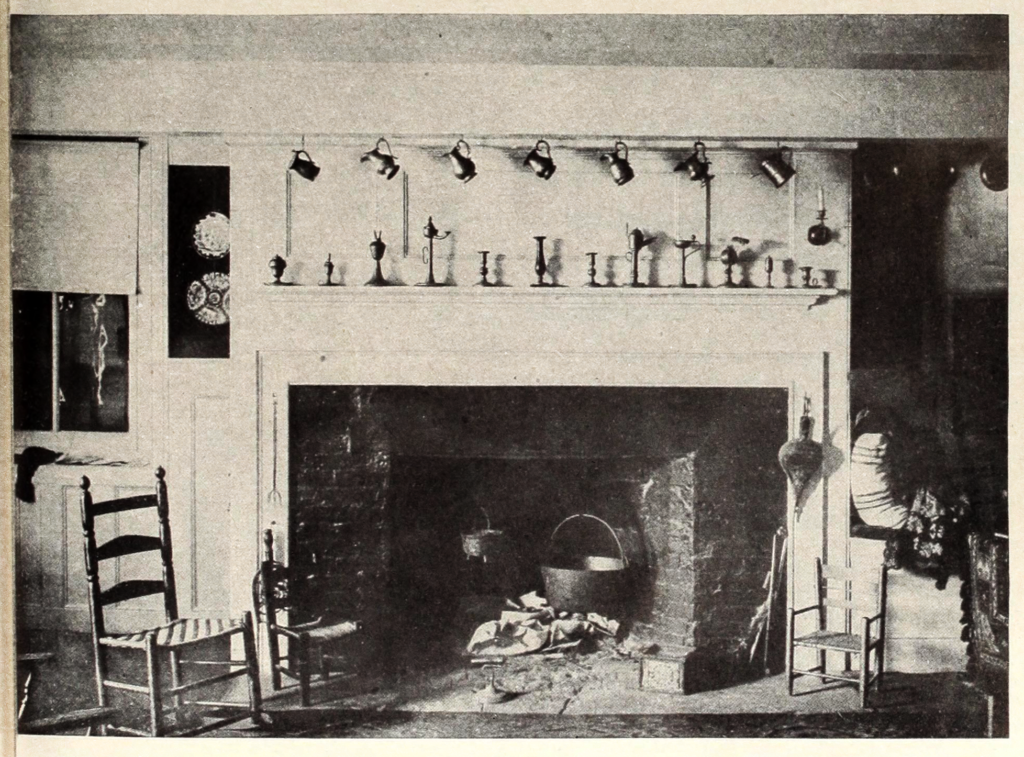
Above photo: The restored living room fireplace. The vandalism that will brick up and hide from sight such a possession as this is difficult to understand.
No sooner was the deed signed, than we opened up the bricked-up fireplaces and tore down the partitions of the bedroom that had been put in the living room, thus restoring the room to its original shape. Then the handy man paneled this room, and between the beams overhead boards were put in so as to have a space of about three feet to the top of the paneling; this was for the burlap to be applied later on; these boards also give an air of finish to the room. We have now a splendid living-room, which we also use for a dining room, 23 ft. long and 17 ft. wide, with four windows.
The spaces between the beams in the other rooms of the main floor were also filled in the same manner. Spruce flooring was put down in the kitchen and summer bedroom and a new stairway was built up to the kitchen garret, turning this into an “antiquarium” for our collection of
antiques and relics.
As we intended putting in a heater, it was necessary to stop all waste heat; so our handy-man hung a floor from the rafters in the main garret, giving us a “space” below and an upper garret, reached by a trap door, for storage; the spaces between the rafters on the sloping sides of the roof were boarded up so as to leave the rafters in sight; these were oiled to make them darker against the new boards, which were left in their natural state.
The stone walls surrounding the upstairs space which we had made in the garret, were pointed up and then boarded in with spruce, the top making a convenient ledge or shelf.
All the door knobs were removed and replaced with brass or iron latches which we came across in our country excursions.
A hot-air heater was put in by contract for $120. The mason work connected with it cost $84.50; this included a brick and stone tunnel for fresh air from the heater to a distant cellar window, 22 feet away, and the insertion of a flue in the library chimney, so placed that it was thoroughly concealed and gave us the full use of the open fireplace. Iron fire-backs were placed in all the fireplaces ; these were especially cast and cost $9. At another date we called in the mason to attend to the kitchen chimney which, having started a little from the wall, was strengthened by a solid stone foundation put under it in the cellar; originally, it sprang from a ledge, 3 in. wide, half way up the cellar wall, and then arched up and over to a big beam; now the new stonework supports it all from the floor. At the same time we had the outside stonework pointed up and the rainwater cistern in the cellar attended to. This bill was $61.80.
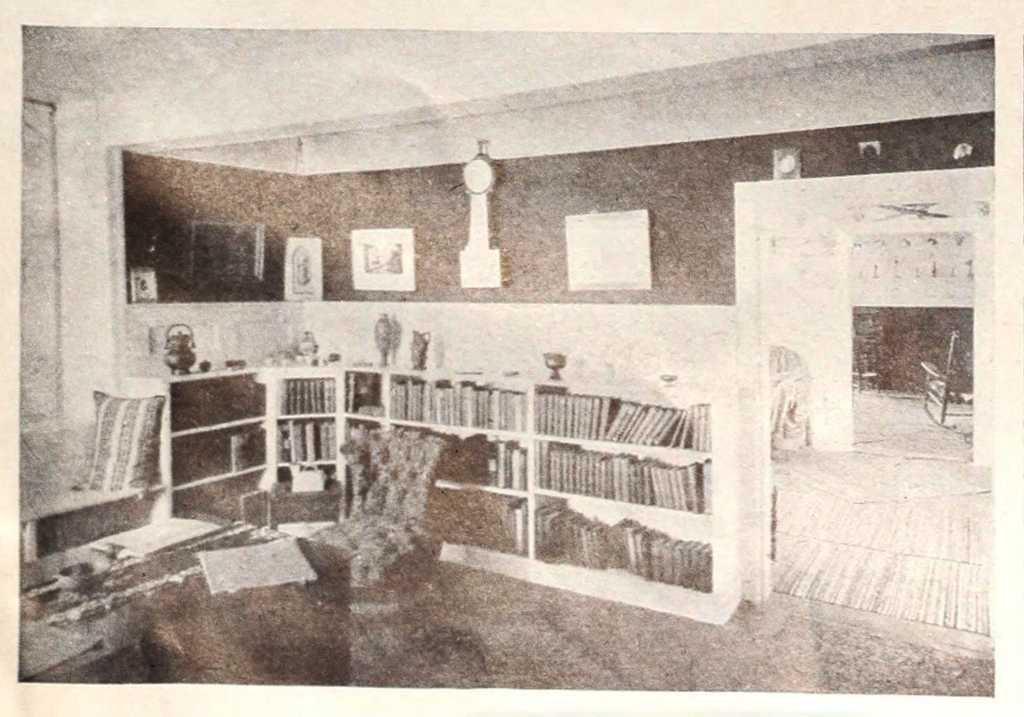
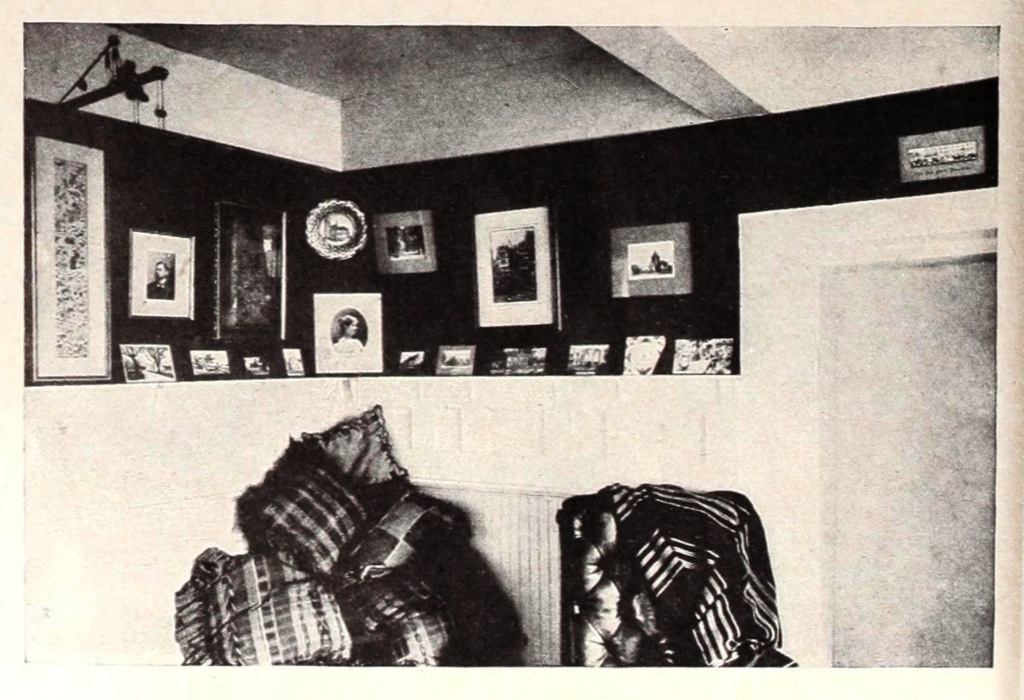
Above left photo: Vista from the library looking across the hall to the living room. Above right photo. The “den” is one of the coziest places in the house.
To insure a supply of rainwater, we had all the house roof connected with the cistern; the necessary material and labor cost $14.59.
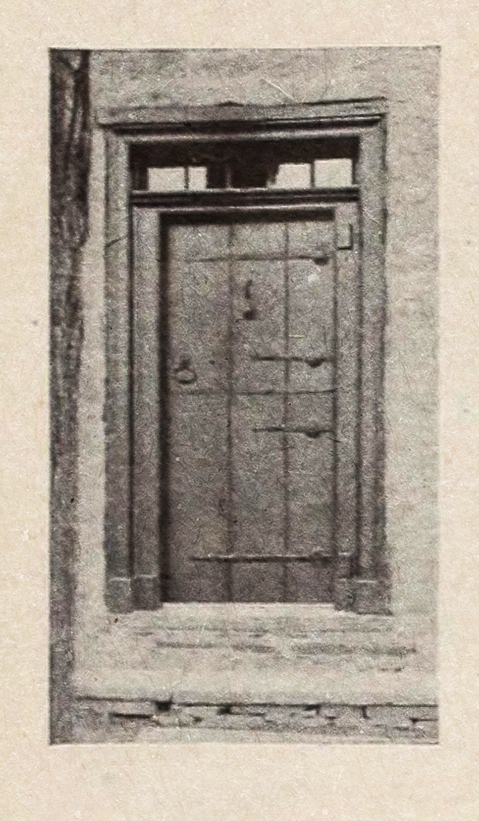
The shingled roof, which was in fair shape at the time of purchase, was badly torn up by the workmen on the chimneys, and a carpenter was engaged to help with this and the rest of the woodwork. One hundred and five bundles of shingles, costing then $1.05 per bundle (now the price is $1.30), were put on the roof. Two dormer windows were inserted in the front roof and a modern front door replaced by a Dutch door; to relieve the bare look of the door, we took old Dutch strap hinges of different lengths, and cutting off the rounded end that fits on the pin, we nailed them to the door, thus giving it a finish; an old wrought-iron knocker, found in Pennsylvania, placed on the door makes it now complete.
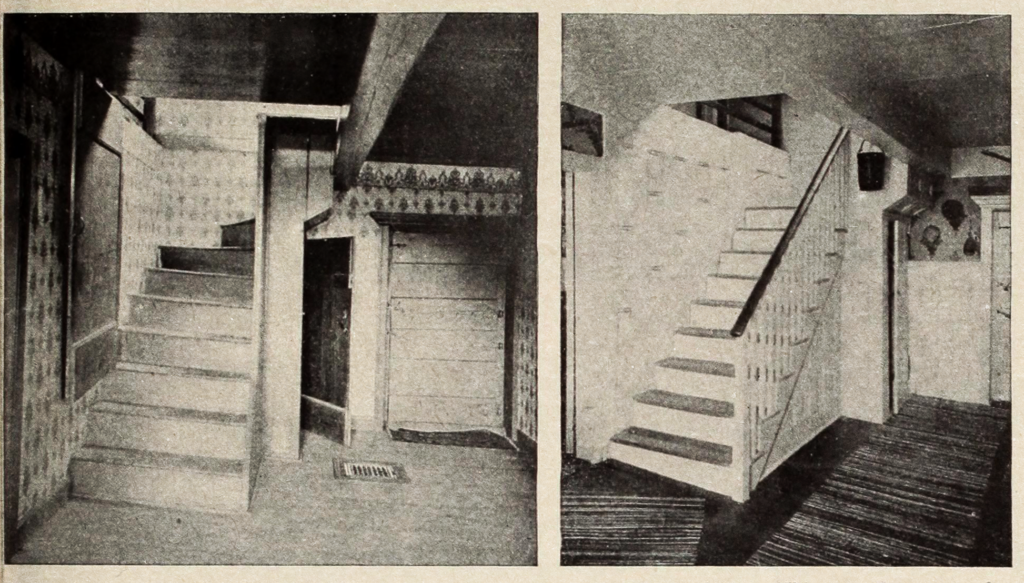
Above photos: The winding staircase in the front hall was a menace to my unaccustomed feet. This was torn out and a straight staircase with a landing erected.
The winding staircase in the front hall was, to my unaccustomed feet, a menace and a source of affliction; this was torn out and a straight staircase with a landing erected.
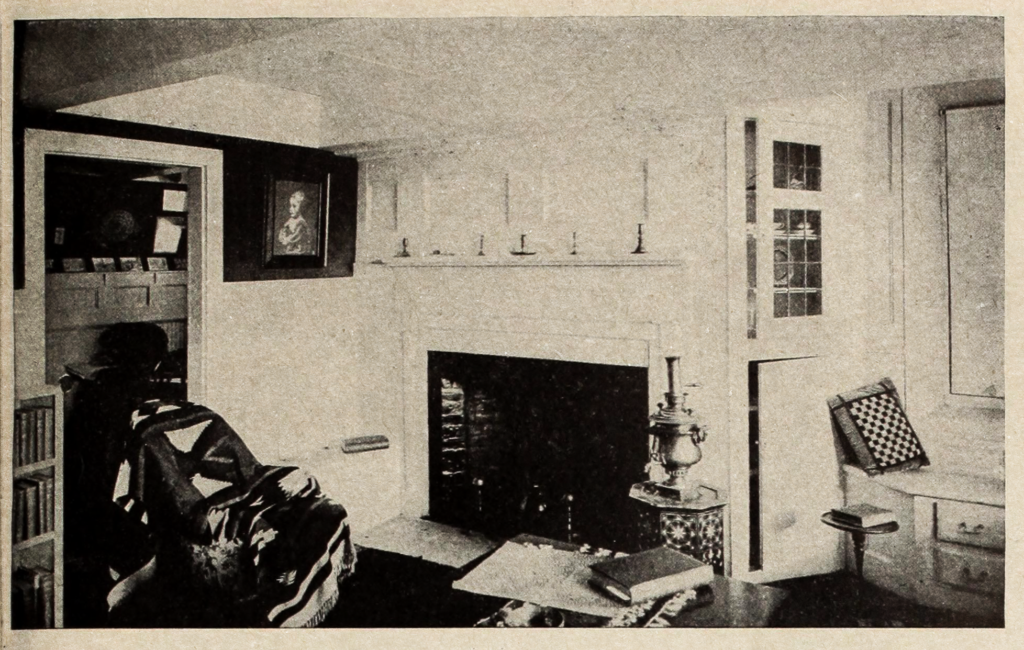
Above photo: The old fireplace in the library showing the cupboards in one end of the chimney. Those in the other end open into the den.
The hall was then paneled and bookcases made in the library around the walls; above these was placed paneling, leaving a strip of wall about 3 ft. wide for the burlap. Under two of the windows handy magazine racks were made, and under the third window a couple of drawers and a convenient little cupboard filled in the space; the tops of all these form cosy lounging places. Adjoining the fireplace a handy woodbox was built in, which makes a fine place to sit and watch the fire. In the “den,” ordinary ceiling boards were used for wainscoting, above which was paneling, topped off by a narrow grooved ledge convenient for pictures and bric-a-brac. Cellar beams were braced up, a kitchen sink made, and the stone walls plugged to attach plate racks; the carpenter’s bill was $87.90.
Years ago, when the desire for modern things prevailed over every feeling of regard for the “old,” the ancient, small-paned windows had been replaced with sash containing 4 panes of glass to a window; to make the house conform to our ideas, of course, these had to come out and windows on the lower floor were fitted with small-paned sash, twenty-four lights to a window, with heavy mullions. The effect is delightfully old.
Any one who has tried to open a window in an old farmhouse, pulling at spring bolts at the side and raising the sash at the same time, knows it is not an easy matter; we wanted something easier. On account of the solid nature of the window-casings, we could not fit in ordinary sash-weights and pulleys, but used sash balances successfully.
The windows in an upstairs bedroom were replaced with casement sash to correspond to other windows on the same floor; they certainly give an air of finish to the room. Ordinary blinds had been placed at these windows; we took out the slats and in their place put panels; now all the windows have solid wooden shutters.
An old wood-cut of the house shows two small windows in each of the gable ends of the house; they were simply 8×10 glass let into the wood-work; while repairing the house years ago they were left out; we restored them at a cost of twenty four cents for the glass, making the frames ourselves, and, to have all the windows uniform, we made tiny wooden shutters for each window.
The sash for eleven windows cost $27.50; the hardware, $5.
The space in the main garret giving possibilities of a bedroom, using the two dormer windows for light, a cosy room was made, all the work being done by ourselves; we utilized an old door with a frame and built the partitions about this frame, using plaster board for the walls instead of lath and plaster; the cracks and crevices were filled up with plaster and then cheesecloth pasted over the walls, over which, when dry, we hung the wallpaper.
The family tore and scraped off every hit of the old wallpaper, in some places three and four layers deep; where the paper had been pasted on the partition beams and other woodwork, it had to be planed off; after this process, we came to strata of whitewashed walls; this we scraped, hoed, and chiseled off, exposing the plaster underneath; in some places this plaster had been laid directly on the stone wall; in others it had been laid on the wall which had been made of oak strips, two inches square, the intervening spaces having been filled in with a mixture of clay and grain chaff; we plastered up all cracks with ready- made plaster (plaster of Paris is apt to shrink) and had the walls ready for the paperhanger.
The family then put on painting uniform, and after covering all knots with shellac, three coats of white paint were put on everything that had been painted white, while colored paint received four coats and we succeeded in getting a dull gloss that looks antique and cottage like. Filling was used on the floors and then they were stained brown; on top of this a finish was laid and we have fine, dull-colored floors for old-fashioned rag-carpet rugs.
At last, after many but interesting days, we were ready for the paperhanger and we found a good one; all the walls received a good quality of sizing and the burlap, which we purchased in the neighboring city, green for the library “den” and red for the living room, was put on lengthways, reducing to minimum the number of seams. We had earlier purchased a paper for the hall that would correspond to the decorations we were to place there; the paperhanger put this on for us; the entire bill for burlap and labor was $29.43.
On the outside of the house several windows had no shutters, so the handy man made them, utilizing old weather-beaten boards from the out-buildings; as soon as the paint was dry, they looked ancient enough to correspond with the house.
Two coats of green paint on the shutters and outer doors, and three coats of white paint on the outside woodwork of the house, were put on to reduce the newness to an apparently respectable age. In addition to the items of expense already mentioned there was purchased:
Lumber, including shingles $361.10
Hardware $21.24
Paint including six brushes $49.51
Preparations for floor $15.55
*The story of the finding of this house was told in the June, 1907, number of Country Life in America.
Article written by George W. Nash, [Sepia] Photographs by the author; Source: Country Life in America July 1909

